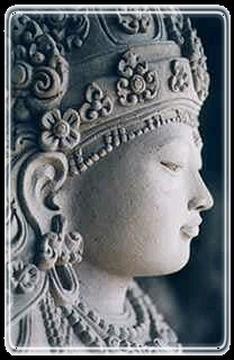
Japan
CLICK ON PHOTOS TO ENLARGE


 Dharmachari Sagaravajra, photographer, sculptor, wanderer, Kiwi, friend and renaissance man, beside the image of Prajnaparamita he created at Rivendel.
Dharmachari Sagaravajra, photographer, sculptor, wanderer, Kiwi, friend and renaissance man, beside the image of Prajnaparamita he created at Rivendel.It was 1999...
...I also had a marvellous time, on pilgrimage, on retreat and visiting friends. For pilgrimage I visited Sankissa, Sravasti, Pharphing and Sikim. Sankissa is one of the eight great pilgrimage places associated with Shakyamuni Buddha. It is here that the Lord descended from heaven after teaching his mother shortly after his enlightenment (some say it was the seventh rains season). It's in the middle of Uttar Pradesh and indeed in the middle of nowhere-I think I am the only member of the Western Buddhist Order ever to visit it, so far. I felt strangely drawn to the place.
Before I left for
Once in
So, out I set into the unknown, and after some culturally shocking experiences arrived at Sankissa. It's a very beautiful place, (mind you I find most of
The road runs past an old village devoid of electricity that rises above the plain on its own mound of ancient ruins, and ends beneath a great gnarled tree at the Stupa's foot. All around the site of the descent is nothing but fields and feathery leafed trees. It was evening when I arrived. A golden sun was setting in a red
Out of the of fields rises the remains of what once must have been a very big stupa, now a mound-not unlike Sillbury hill, but with what looks like, and probably once was, a brick castle on top. The castle or fort is now filled in or levelled off so that assenting the stairs up through the old portal one arrives on a terrace on which sit a couple of basic Hindu shrines. The Devi who inhabits the shrine here looks so similar to Avaloketeshvara one wonders if this isn't an instance of a farmer digging up a Buddhist rupa and beginning to worship him in the only way he knows how. The only image of the Buddha here is tucked away in a tiny temple at some distance before the Stupa. It is an ancient black stone image of the descent. On either side of the Lord are Indra and Brahma who accompanied Shakyamuni back to earth, each on their own stairs. Indra's was Blue; Brahma's was Silver, while between them the supreme Lord descended on stairs of gold. I preferred to imagine the stairs in more modern terms, seeing them descend through rays of light.
I learnt that the event that occurred here was called a Prattihara. Apparently a Prattihara is a very rare moment when the barrier between the Kammaloka (our realm of desire) and the Rupaloka (the realm of beauty, inhabited by gods) is removed, when the gods could see the world and the world could see the gods.
It must have been a very very beautiful moment.